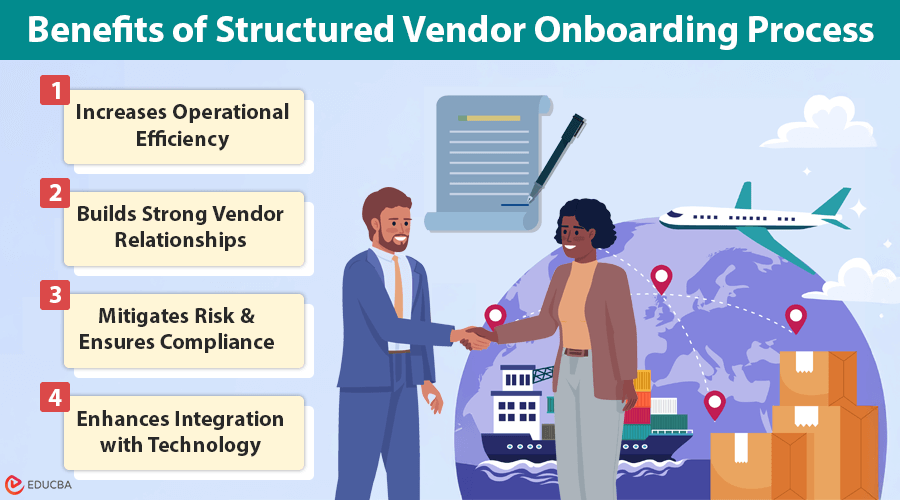
Importance of a Structured Vendor Onboarding
A well-organized vendor onboarding process is crucial for companies that want to establish strong, long-term relationships with their suppliers. Rather than just being an essential administrative task, a structured onboarding approach helps businesses streamline operations, reduce risks, and foster collaboration with new vendors. This article outlines the benefits of structured vendor onboarding, highlighting how it can improve efficiency, reduce risks, and foster growth.
What is the Vendor Onboarding Process?
The vendor onboarding process refers to an organization’s steps for integrating a new vendor into its systems and operations. It involves introducing the vendor to the company’s requirements, policies, and culture and ensuring alignment with its objectives and values.
By creating a structured onboarding process, companies can set clear expectations from the start, minimize risks, and develop strong, collaborative relationships with vendors. This approach makes the procurement process smoother and more efficient for both parties.
Key Benefits of Structured Vendor Onboarding Process
A well-organized vendor onboarding process offers a range of advantages, including operational efficiency, risk management, and long-term vendor relationships. Below are the key benefits that organizations can gain from implementing a structured onboarding process.
#1. Increases Operational Efficiency
One main benefit of organized vendor onboarding is improved operational efficiency. By streamlining procurement workflows, organizations can reduce administrative tasks and minimize delays. Standardizing documentation, setting evaluation protocols, and ensuring clear communication also help speed up vendor integration.
This efficiency also enables organizations to adapt quickly to changing business needs, ensuring a responsive procurement framework aligned with market dynamics.
#2. Builds Strong Vendor Relationships
A well-structured onboarding process helps build trust between the organization and the vendor. It is an opportunity for vendors to understand the organization’s operational needs, cultural nuances, and expectations. This mutual understanding helps create a strong foundation for a long-term, collaborative partnership.
When vendors feel welcomed and informed from the beginning, they are more likely to align their services with the organization’s goals, fostering innovation and collaboration.
#3. Mitigates Risk and Ensures Compliance
Another key benefit of structured vendor onboarding is risk management. A comprehensive onboarding process allows organizations to conduct background checks, assess potential risks, and ensure that vendors meet all necessary legal and financial standards. This reduces the likelihood of problems arising during the partnership.
Organizations protect themselves from potential legal issues and safeguard their reputations by complying with industry regulations and internal policies.
#4. Enhances Integration with Technology
Modern vendor onboarding processes leverage technology to improve efficiency and transparency. Digital tools enable real-time document exchange, automatic verification, and performance tracking, which help organizations manage their vendor relationships more effectively.
These technologies speed up onboarding and provide valuable insights into vendor capabilities and performance, helping organizations make informed decisions.
#5. Promotes Sustainability and Ethical Practices
Sustainability is increasingly essential in vendor selection. As part of the vendor onboarding process, organizations evaluate vendors based on their environmental practices and commitment to sustainability. Organizations can promote ethical business practices and reduce environmental impact by choosing vendors who align with their values.
This focus on sustainability can also create a positive ripple effect across the supply chain, ensuring that vendors prioritize responsible practices.
#6. Sets Clear Performance Benchmarks
Structured vendor onboarding sets clear expectations for performance. Organizations can track and evaluate vendor contributions by defining key performance indicators (KPIs) from the outset. Regular performance reviews and feedback sessions help pinpoint areas for improvement and encourage a culture of ongoing optimization.
This ongoing evaluation ensures that vendor relationships remain dynamic and aligned with the organization’s evolving objectives.
#7. Aligns with Organizational Culture and Strategy
The vendor onboarding process is not just about meeting technical requirements. It is also about cultural and strategic alignment. Vendors who understand and align with the organization’s values and long-term vision are more likely to contribute positively to the relationship.
Organizations can build deeper, more meaningful partnerships beyond transactional interactions by focusing on strategic alignment.
#8. Drives Cost Savings
A structured vendor onboarding process offers significant financial and operational benefits. Organizations can lower operational costs and optimize resource allocation by reducing administrative burdens, mitigating risks, and improving vendor integration, leading to better financial performance and more efficient resource use.
Final Thoughts
A structured vendor onboarding process is much more than a routine administrative task; it is a strategic initiative that can enhance operational efficiency, reduce risks, build strong partnerships, and align with sustainability goals. Organizations that invest time and effort into creating an effective vendor onboarding process are better equipped to thrive in the competitive and ever-changing business landscape. By focusing on the benefits of structured vendor onboarding, companies can turn their vendor relationships into long-lasting, value-driven partnerships that drive innovation, growth, and success.
Recommended Articles
We hope this guide on the benefits of structured vendor onboarding helps you streamline your processes and build strong, reliable vendor relationships. Check out these recommended articles for more insights into optimizing supply chain management and boosting efficiency.
